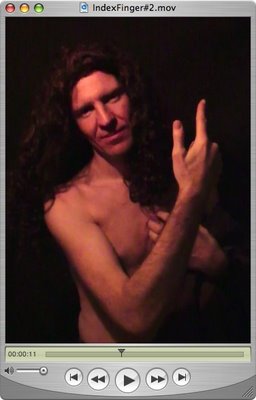
Watch this clip
IndexFinger #1 is part of a photographic video portrait series on the decisive role of a gesture, namely the index finger, throughout the history of religion, philosophy, and pop-culture. #1 is a psycho-dramatic imitation of Wilhelm Busch's famous 19th century graphic novel, Max and Moritz (http://www.fln.vcu.edu/mm/mmeng4.html) which still plays an essential role in German-speaking popular culture. The depicted part is based on the illustration of the fourth trick. This segment focuses on Lehrer Laempel, the heamadster of the local school who is a feared moral authority. As the story unfolds he gets blown up by the two main characters who are child pranksters, Max and Moritz. The novel itself is a cautionary tale about the destructiveness and the drama resulting from going over the edge of naughtiness. The video portraits were created by Richard Jochum and greatly supported by Aphrodite Désirée Navab. Altogether they constitute a tryptich installation which will be part of the group exhibition, "What's Good Must Not Necessarily Be Evil", at Kunstraum Vaduz, Liechtenstein in April/May 2007.

Watch this clip
IndexFinger #2 is part of a photographic video portrait series on the decisive role of a gesture, namely the index finger, throughout the history of religion, philosophy, and pop-culture. #2 is a psycho-dramatic imitation of Leonarda Da Vinci's famous oil painting, Saint John the Baptist, painted between 1513-1516, housed in the Louvre, Paris. Da Vinci's paintings often depict esoteric, androgynous characters with a slight touch of an almost diabolic darkness. John the Baptist shows the saint pointing towards somebody else, the gesture of a disciple towards his master. The video portraits were created by Richard Jochum and greatly supported by Aphrodite Desiree Navab. Altogether they constitute a tryptich installation which will be part of the group exhibition, "What's Good Must Not Necessarily Be Evil", at Kunstraum Vaduz, Liechtenstein in April/May 2007.

Watch this clip
IndexFinger #3 is part of a photographic video portrait series on the decisive role of a gesture, namely the index finger, throughout the history of religion, philosophy, and pop-culture. #3 is a psycho-dramatic imitation of Raphael's famous fresco "The School of Athens" depicting the major philosophers of ancient Greece. One of its central figures, Plato, serves as a template for the 3rd video portrait, showing him while holding his right arm up and pointing with his index finger towards -- most likely -- the sun as a sympol for the scholastic trinity of the good, the whole, and the truth. Raphael's fresco from 1510-11, housed in the Museum of the Vatican, is frequently a focal point of an inflamed debate among art historians over its historical value, yet it was understood to be one of the central paintings introducing neoplatonism in Italy. The video portraits were created by Richard Jochum and greatly supported by Aphrodite Desiree Navab. Altogether they constitute a tryptich installation which will be part of the group exhibition, "What's Good Must Not Necessarily Be Evil", at Kunstraum Vaduz, Liechtenstein in April/May 2007.

No comments:
Post a Comment